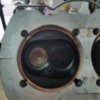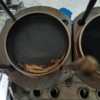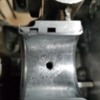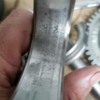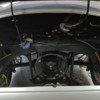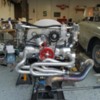oh, and cars really back-fire when that gear is almost gone, the timing gets really wanky, whether or not you've been feeding it gluten-free or not...
Engine is now fully disassembled. All the bearings are trashed. Good news is the crank journals are all ok. The cam, lifters, and pushrods are good too.
Bobby, how many miles/kms on the engine?
Have you determined the cause of death? Do we get to see a pic of the brass gear?
It sounds like a piston to me. When engines get very hot, sometimes the piston skirt will collapse and the engine will develop a knock at idle. The colder the engine, the worse the knock will be.
That's how my knees feel after I turned 60 or so - the colder out it is, the more they "click" when I walk. Trouble is, nobody ever turned "click-kneed" into daily conversation so people just look at me weird.
"Knock-kneed"? Sure...Everyone knows that. "Click-Kneed"? Nope - never heard of it.
I think Pat's on to the cause. I've driven hotter VW engines without a fan belt for maybe a 1/4 of a mile but that's about it. Doing a mile in moderate traffic with no cooling might have been the kiss of death (but Bobby's wife doesn't have to know that - most people these days don't drive with air-cooled engines on 4 wheels and simply don't know).
Sorry Guys,
Its been a busy weekend. I have checked out the crank journal and Plastigaged them with the new main bearings and everything is within tolerances. When I get the rod bearing later this week I will test them on the journals as well. The pistons looked fine except for the black carbon that coated the tops and heads. After cleaning them up they all looked okay.
I terms of the brass shaving. I know when it happened. During our initial assembly I had the distributor drive gear installed without the distributor. At some point I turned the motor backward the drive gear tried to climb out. But I was unaware of the situation. The crank was turning but it was very hard. What was happening was I was grinding the brass gear over the drive gear and tearing it up. I pulled the gear out and it was loaded with shaving. I cleaned the gear up and thought I cleaned up the compartment. But Instead of doing the right thing and splitting the block up again, I assumed I got all the shavings and finished the build. Big mistake on my part.
Today while working on getting piston back into their jugs, I noticed the bottom ring on the number 1 piston was stuck. The scraper and the two border rings could not rotate. I had to disassemble them and re-assemble. They seemed fine afterwords.
Today I also ordered a Datoka Digital CMT gauge. I never felt comfortable driving the car and not really knowing if the engine was too hot or not. I don't trust the temp gauge built into the cluster.
Attached are some picture for your entertainment and my pain.
Attachments
Is that crack in the second picture benign?
Jethro
The last two pictures on the left are the bearings for the cam and crankshaft. The actual Cam and Crankshaft have no damage. I think the softer metal of the bearings saved the cam and crank. I am so glad I pulled the motor. It had less than 100 miles on it. Any longer could have destroyed the whole thing.
Jethro posted:Is that crack in the second picture benign?
It "just" looks like a cracked cooling fin on the cylinder. It's not a sealing surface so causes negligible cooling difference.

Attachments
I just took a closer look. It is not a crack. It looks like flashing from the casting. It sits above the fine not down in it. Good eye Jethro
Hey Guys
I just finished the motor rebuild. I had to change all the bearings but everything else was ok. I also lowered the compression ratio from 9.4 down to 9.0. With this rebuild, I have also purchased a Dakota Digital CHT gauge and oil temp gauge which will be installed with the motor.
While I have the motor out of the car, I thought now would be a good time to do any modifications to the engine bay for more cooling. I have read on this forum putting a large hole in front of the intake fan on the firewall can help get more cool air into the bay. Our car is a Beck and the firewall is not just a wall, it has a large shelf on it. This shelf makes it difficult to cut a hole directly in front of the cooling fan. I have attached a picture of the engine bay for a reference. Any ideas or recommendations would be welcome. You can see in the picture, there is a fan on the shelf that was used to feed air to the heater boxes. I am not using the heater boxes. Would it best to run that fan as well to pull air in or remove it and leave the hole as an entry point.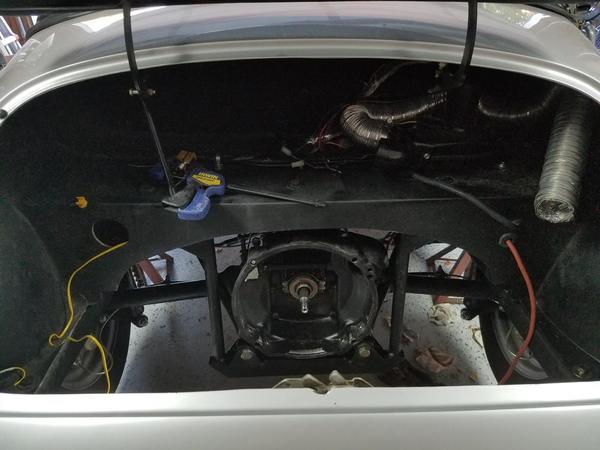
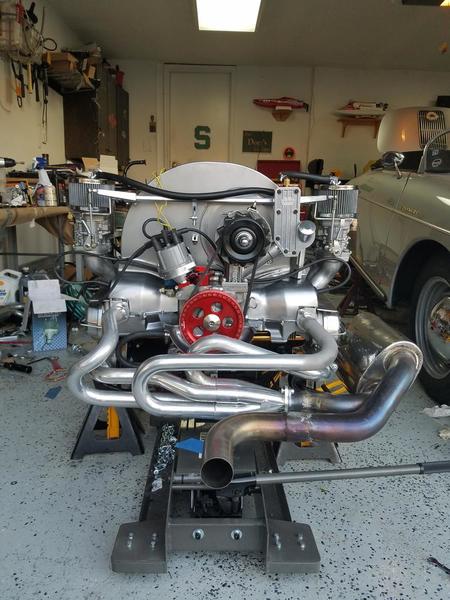
Attachments
TWIN OIL coolers up front with fans.....cool oil helps but some DOLLARS for equipment setup.
Up front as in behind the nose? If so that a long run back to the motor...
crhemi (Bill) poboiinhawaii posted:Up front as in behind the nose? If so that a long run back to the motor...
YES INDEED but that is where MOST cooling takes place as car accelerated THRU wind AND leaves motor's hot air behind....most RADIATORS and COOLING sinks are fitted up front.
BANZAI:
Yes, that is the set up for 911 engines. Not sure about yours, but mine is a dry sump, and with 11 quarts of oil, there's lots there to keep going through those long hoses from the engine and oil tank to the dual oil coolers up front.
I don't think you could do that with a four cylinder, sumped engine. Many of those will have a fan driven oil cooler in the rear wheel well. That's where my previous IMs had it.
CLEAN Air!!!
you need fresh air to the oil cooler and the hot air to escape the car without being sucked back in thru the motor. running a cooler up front is good, but you need a good blueprinted pump to push the oil up thru the hoses to the cooler and back.
mount it in the rear fender, be sure your engine tin is fitted correctly. good seal around the oil cooler on the shroud. all the parts, fan, oil cooler, proper jetting and brad penn oil make the difference.
If a guy wants to put those oil coolers up front, a dry sump system (like a 911s) is pretty much the price of entry, unless you're looking for problems. In that application, the coolers would go in the first stage circuit, not the second.
In a standard wet-sump application, the coolers are between the oil pump and the bearings. Personally, I wouldn't want my oil going through 15 feet of line and a couple of coolers before it made its way into the galleries, but that's just me. Absent some check-valves (which I also think are a bad idea idea), I'll bet it would take about 15 seconds to build any oil pressure after start up. Engines are kind of expensive. That seems like wearing one out on purpose.
I've GOT a dry sump. An oil change takes 9 quarts. I saw no reason to put mine up there. I've never regretted it.
Putting mine up front in the Spyder. Plumbing an Accusump accumulator to pressurize on startup.
Big mistake?
edsnova posted:Putting mine up front in the Spyder. Plumbing an Accusump accumulator to pressurize on startup.
Big mistake?
You'll need a BIG sump.
Alternately, you could dry-sump it. It's really the cat's meow. Seriously.
Stan Galat, '05 IM, 2276, Nowhere, USA posted:edsnova posted:Putting mine up front in the Spyder. Plumbing an Accusump accumulator to pressurize on startup.
Big mistake?
You'll need a BIG sump.
Alternately, you could dry-sump it. It's really the cat's meow. Seriously.
STAN KNOWS his COOLING...absolutely CORRECT A to Z!
I agree with Stan, dry sump in Spider is the way to go. I would do a dry sump in speedster also. But the average owner doesn't need it unless they want to take it to the next level.
OK, help me think this through before we get too deep into it. The engine is going to have a stock cooler (to start). It's got the full-flowed case for a remote filter. The filter will get a Mocal sandwich to direct oil to the remote cooler up front.
My understanding (and this is key: I'm not entirely confident that I understand anything, so help me out) is that the oil flows from the sump through the pickup to the pump, then out to the filter mount, which has a relief valve to allow a filter bypass at startup or when the oil is too cold/thick and might blow up the filter, then back to the bearings & such.
The Mocal sandwich has a thermostat that directs most of the oil into the filter/relief valve when cold, but opens up at 180F to push most of the oil out to the cooler (where ever that is), where it passes the plates and returns to the sandwich.
Not sure if the thermostat is before or after the filter, but whatever. The important thing (which, again, I think I know but am anxious to reconsider) is:
By mounting the remote filter, with the sandwich, close to the engine, the oil circuit on startup is roughly the same volume as it would be on a stock, filterless engine.
Now. Once the oil heats up and has to go to the remote cooler, we have to consider the oil volume there. I think this is the concern Stan has about "deep sump." He seems to be saying that the cooler and its looong hoses empty out when the engine is off. That would send x pints of oil into the crankcase, necessitating the deep sump, where x=the volume of oil carried by the two six-foot oil hoses and the cooler, yeah?
But what if the sandwich plate is mounted just above the correct level in the crank case? And what if the top of the oil cooler is barely higher than that?
Now you have a situation in which the oil mostly stays in the cooler (and the looong oil lines) at shut down, do you not? And the key engineering challenge then is to install a petcock at or near the cooler to drain the oil from that system at oil change time.
All of this, of course, does not consider the Accusump, a two-quart holding tank that (again, by my limited, noobie, theoretical understanding), accumulates oil when the pressure in the system is high—say, over 8 or 10 psi—and then spits it back into the system (i.e., the oil galley, the bearings, etc.) when the pressure drops. This is to prevent oil starvation on hard cornering or at other times when the sump may become uncovered. It's also a handy-dandy pre-oiler if wired to the key, so it spits oil when you turn the key on before the engine starts (i.e. zero pressure on the engine side) but then sucks the oil back out immediately after the engine starts (i.e. 40 psi on startup because the oil is cold).
So I think I can have a system that works roughly as follows (volumes approximate pending my check of actual values):
Engine with shallow add-on sump: 3.5 quarts
Accusump: 1 quart, (plus one quart of air space).
Filter & short hoses: 1 quart
Accessory cooler and loooong hoses: 2 quarts
Total system oil: 7.5 quarts.
Now in various conditions (in all cases I assume the filter and its hoses hold a quart):
Prestartup oil in sump: 3.5—4 quarts
Prestartup oil in Accusump: 1-2 quarts
Prestartup oil in cooler and loooong hoses: 1.5 quarts
+++
Cold running oil in sump: 2.5-3.5 quarts
Cold running oil in Accusump: 2 quarts
Cold running oil in cooler and looooong hoses: 1.5-2 quarts (the Mocal will send a little oil right off, and fill this system up after a minute or two)
+++
Hot running oil in sump: 2-3.5 quarts
Hot running oil in Accusump: .5-1.5 quarts
Hot running oil in cooler and long hoses: 2 quarts
OK, men-who-build-engines-and-oil-systems, please set me straight. Am I on crack here, or solid ground? And if so, why?
You're a smart guy, and you think stuff through, so I'm not ever going to be the guy to tell you what to do.
I think the key to putting the cooler in the front with a wet-sump oiling system is to keep the oil in the lines and cooler during the off-cycle.
If the cooler and lines are higher than the sump, they'll drain back into the sump while the car sits, unless there are precautions taken to make sure they don't. If the oil drains back, you're screwed-- because the quart or so in the Accusump is going to be inadequate to even fill the oil cooler and lines, let alone pressurize the gallies.
Perhaps the oil inlet into the galley is high enough to prevent drain-back, but if it were me, I'd probably put some sort of inverted trap in both the line from the oil pump and the line returning to the engine, to try to keep the oil in the filter/lines/cooler. I'd think the thermostat would help with the drain-back during the off-cycle, but you'll want to make sure you have a good one.
No matter what, it's going to take a big, blueprinted, quality 30 mm pump. There's going to be no small amount of pressure drop pushing the oil all the way up there and back, especially when it's cold. I'd think you'd want at least 5/8 tubing to keep the pressure drop in line. As I see it, the problem is the volume of oil in those lines-- there's nearly as much oil in cooler circuit as in the entire rest of the system. Keeping it where it belongs (as I said) is what would be required to make this work.
If the oil does drain back, when you use the Accusump to pre-lube, you'll be filling the oil lines and cooler in addition to the galleys. The lines being full, and making sure the oil doesn't flow backward through the oil pump is kind've key to using the Accusump in this way. The Accusump is an amazing bit of kit, but I'm reluctant to rely on it as a means of keeping the galley pressurized anytime besides start-up. It's nice to have, but it should be a last resort.
If you were dry-sumping this, you'd put the (up front) oil cooler in the first stage circuit. A dry-sump has at least two stages-- let's call them the scavenging side and the pressure side. If I wanted the oil cooler(s) up front, I'd put the filter, cooler, lines, etc. all in the scavenging side. With a dry-sump, it doesn't matter where the oil is during the off-cycle, as long as there is some in the tank to supply the pressure side and feed the engine.
I've got my cooler, filter, etc. in the pressure side because the piping worked out better that way and the lines are really short. If I were doing it again, I'd put them in the scavenging side.
Actually, the only reason NOT to dry-sump that I can see is the header, and a spyder header will clear a Bugpack dry-sump pump. I'm not sure why everybody thinks this is such an exotic thing to do, but it's really just a pump and a tank. Once you do it, you can drop the car as low as you want, and never worry about hitting anything but the header.
But if you don't want to do it, you don't want to do it-- and as I said, you're a smart guy who thinks stuff through. Regardless, I'm excited to see what you come up with.
Stan said: "Personally, I wouldn't want my oil going through 15 feet of line and a couple of coolers before it made its way into the galleries, but that's just me. Absent some check-valves (which I also think are a bad idea idea), I'll bet it would take about 15 seconds to build any oil pressure after start up. Engines are kind of expensive. That seems like wearing one out on purpose."
Stan, Porsche used this set up for years with no issues at start up. I have twin coolers at the front, an oil tank right next to the engine, and no problems.
Am I misunderstanding what you are saying here?
Bob: IM S6 posted:Stan said: "Personally, I wouldn't want my oil going through 15 feet of line and a couple of coolers before it made its way into the galleries, but that's just me. Absent some check-valves (which I also think are a bad idea idea), I'll bet it would take about 15 seconds to build any oil pressure after start up. Engines are kind of expensive. That seems like wearing one out on purpose."
Stan, Porsche used this set up for years with no issues at start up. I have twin coolers at the front, an oil tank right next to the engine, and no problems.
Am I misunderstanding what you are saying here?
Yes.
You have a dry-sump and your oil cooler and lines (as well as filters, etc.) are all in the scavenging circuit (first stage, before the oil gets into the tank), not the pressure circuit where the galleys are. This is one of the reasons Porsche went to a dry-sump with the 911.
Stan Galat, '05 IM, 2276, Nowhere, USA posted:Bob: IM S6 posted:Stan said: "Personally, I wouldn't want my oil going through 15 feet of line and a couple of coolers before it made its way into the galleries, but that's just me. Absent some check-valves (which I also think are a bad idea idea), I'll bet it would take about 15 seconds to build any oil pressure after start up. Engines are kind of expensive. That seems like wearing one out on purpose."
Stan, Porsche used this set up for years with no issues at start up. I have twin coolers at the front, an oil tank right next to the engine, and no problems.
Am I misunderstanding what you are saying here?
Yes.
You have a dry-sump and your oil cooler and lines (as well as filters, etc.) are all in the scavenging circuit (first stage, before the oil gets into the tank), not the pressure circuit where the galleys are. This is one of the reasons Porsche went to a dry-sump with the 911.
GOODNESS....I cannot wrap my head around all of these oil circuits but GLAD my system works ![]() .
.
Suntan oil, I understand sun tan oil and it doesn't require cooling or plumbing. The stuff above, I don't understand very well.
Stan Galat, '05 IM, 2276, Nowhere, USA posted:Bob: IM S6 posted:Stan said: "Personally, I wouldn't want my oil going through 15 feet of line and a couple of coolers before it made its way into the galleries, but that's just me. Absent some check-valves (which I also think are a bad idea idea), I'll bet it would take about 15 seconds to build any oil pressure after start up. Engines are kind of expensive. That seems like wearing one out on purpose."
Stan, Porsche used this set up for years with no issues at start up. I have twin coolers at the front, an oil tank right next to the engine, and no problems.
Am I misunderstanding what you are saying here?
Yes.
You have a dry-sump and your oil cooler and lines (as well as filters, etc.) are all in the scavenging circuit (first stage, before the oil gets into the tank), not the pressure circuit where the galleys are. This is one of the reasons Porsche went to a dry-sump with the 911.
READ UP on DRY SUMP((GOOGLE) has good explanations....buy YES the DRY SUMP works well altho not much is DRY(?)![]()
![]()
Welp. Looks like my guess about the oil in the loooong hoses was off. It'll be about a gallon, not 2 quarts.
Per the Raby spec sheet, the engine itself is deep-sumped and holds 4.5 quarts. Not 3.5.
So as-is I'll be loading about 9 quarts into her on startup. That's a lot of green stuff.
Dry-sumping looks like a spendy proposition as well. New pump is like $150 from CBP. Looks like a dry sump tank starts around $300. I'm sure there would be more expenses. Could sell the Accusump to recoup some, but would still end up with 9 quarts in her and $500 lighter....
All this for what is, at base, a mild 1914, fully-built, tested and tuned already?
Seems like the way forward would be to simplify, put the cooler somewhere under the clamshell & call it a day. Make it like 5 or 6 quarts all in. But.
Still trying to figure why running what I'm contemplating would be bad. Why would the oil pump care how much oil is in the system so long as it's not asked to lift the oil much higher than stock spec? The system I penned out would be lower than the stock doghouse oil cooler. The oil in the remote cooler branch of the system wouldn't have to move all that much until after the oil in the engine reached 180F.
Has anyone we know tried this idea out? And failed? I want a failure to chime in here, or someone who witnessed one first-hand.
Thanks, all.
edsnova posted:Welp. Looks like my guess about the oil in the loooong hoses was off. It'll be about a gallon, not 2 quarts.
Per the Raby spec sheet, the engine itself is deep-sumped and holds 4.5 quarts. Not 3.5.
So as-is I'll be loading about 9 quarts into her on startup. That's a lot of green stuff.
Dry-sumping looks like a spendy proposition as well. New pump is like $150 from CBP. Looks like a dry sump tank starts around $300. I'm sure there would be more expenses. Could sell the Accusump to recoup some, but would still end up with 9 quarts in her and $500 lighter....
All this for what is, at base, a mild 1914, fully-built, tested and tuned already?
Seems like the way forward would be to simplify, put the cooler somewhere under the clamshell & call it a day. Make it like 5 or 6 quarts all in. But.
Still trying to figure why running what I'm contemplating would be bad. Why would the oil pump care how much oil is in the system so long as it's not asked to lift the oil much higher than stock spec? The system I penned out would be lower than the stock doghouse oil cooler. The oil in the remote cooler branch of the system wouldn't have to move all that much until after the oil in the engine reached 180F.
Has anyone we know tried this idea out? And failed? I want a failure to chime in here, or someone who witnessed one first-hand.
Thanks, all.
Cost factor is always an issue. Buy a setrab cooler with fan pack! Mount it in the left rear fender well, ask Mitch or Terry for pictures of theirs. The oil filter is mounted near by and then you have short oil hoses and good setup. As for oil draining into sump it is not a big of an issue as with a dry sump tank. Once you lay it out you will see.
Stop over thinking the basic system, this sight offers plenty advice because they all have been there.
"This is one of the reasons Porsche went to a dry-sump with the 911."
If I recall, the main reason was for prevention of oil starvation at high speed cornering. It also helps under carriage clearance.
But, it gives me something to talk about when people inquire about the car, so it makes me look more knowledgeable...


